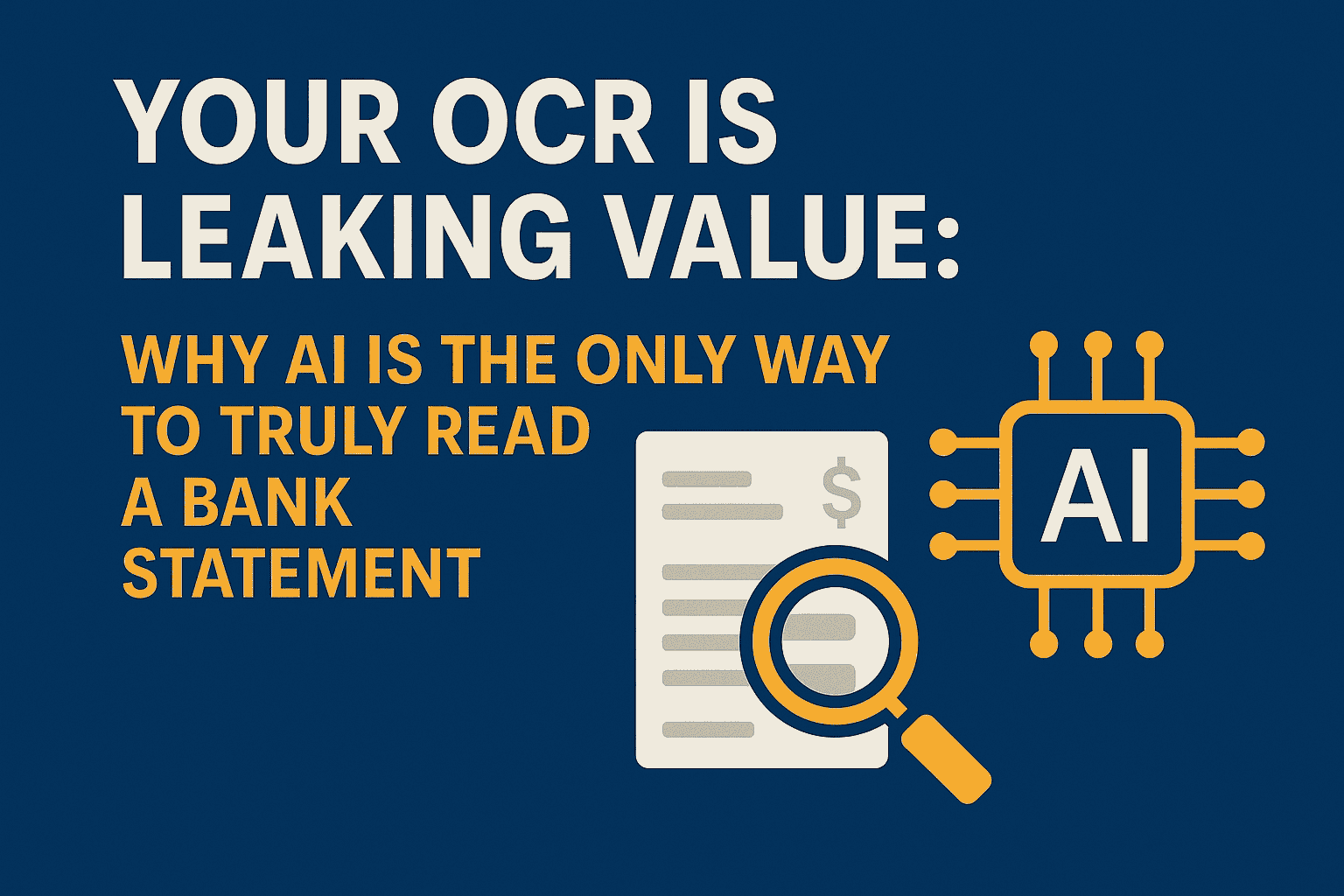
Your OCR is Leaking Value: Why AI is the Only Way to Truly Read a Bank Statement
For years, Optical Character Recognition (OCR) has been the workhorse of document digitization. It was a revolutionary step forward, freeing us from the drudgery of manual data entry by turning scanned images into machine-readable text. But in the high-stakes world of financial analysis and lending, we’ve hit the ceiling of what OCR can do. When it comes to a document as nuanced and critical as a bank statement, simply “reading” the text is not enough. OCR extracts characters; it doesn’t provide understanding. This is where it fails, and where a new generation of AI is fundamentally changing the game.
The Blind Spots of Traditional OCR
Think about how you, a human analyst, read a bank statement. You don’t just see numbers and words; you see structure, context, and relationships. You understand that deposits increase a balance while withdrawals decrease it. You can identify a recurring payroll deposit versus a one-time wire transfer.
Traditional OCR sees none of this. It operates with a set of critical limitations that make it unfit for deep financial analysis:
- It Lacks Contextual Understanding: OCR can pull the number “$5,250.00” and the words “Ending Balance,” but it doesn’t understand the relationship between them. It can’t differentiate between a key financial metric and a passing mention in a text block. This lack of context means the extracted data is just a flat file of text, requiring a human to manually piece it back together and make sense of it.
- It Breaks on Complex Layouts: Bank statements are rarely simple, single-column documents. They contain intricate tables, multi-level line items, and varied formats from different banks. OCR struggles mightily with this, often jumbling the data, losing the original formatting, and making it impossible to tell which numbers belong to which labels.
- It’s Fragile: The accuracy of OCR plummets with real-world document quality issues like low-resolution scans, blurry text, or even colored backgrounds—all common occurrences when dealing with documents from various sources.
- It Can’t Analyze Anything: OCR’s job ends the moment it converts an image to text. It cannot perform calculations, identify trends, flag discrepancies, or provide any of the analytical insights that are the entire point of reviewing a bank statement in the first place. For a detailed breakdown of these limitations, check our comparison of AI vs manual review vs traditional OCR that shows exactly where older methods fall short.
The AI Leap: From Text Recognition to Financial Comprehension
This is where platforms like Exathinklabs are creating a new standard. By leveraging AI and machine learning, they move beyond simple character recognition into the realm of Intelligent Document Processing (IDP). This isn’t just a better OCR; it’s a completely different approach.
An AI model trained specifically on financial documents doesn’t just see text; it comprehends financial concepts.
- It Understands Structure and Meaning: An AI platform knows what a bank statement is supposed to look like. It can identify and parse complex tables, correctly associate values with their corresponding line items, and understand the hierarchical nature of financial data. It reads the document holistically, preserving the critical structure that OCR destroys.
- It Analyzes and Validates: This is the most significant leap. An AI-powered platform doesn’t just hand you raw data. It can automatically calculate key financial ratios, compare data across different documents to flag inconsistencies, and automate credit risk analysis by analyzing the metrics that matter.
- It’s Built for the Real World: Unlike fragile OCR, robust AI systems are designed to handle the messy reality of unstructured data. They can process a wide variety of document formats and qualities, from pristine PDFs to scanned images, without losing accuracy.
Exathinklabs: Where AI Delivers Financial Insight
Exathinklabs exemplifies this new paradigm. Our platform is not a generic OCR tool with an “AI” label slapped on; it’s a purpose-built engine for financial document analysis. With a claimed 99.8% detection rate, it delivers the accuracy that financial decisions depend on.
The platform’s workflow highlights the difference. It begins with secure document uploads and moves to AI-powered analysis that includes intelligent classification, pattern recognition, and trend analysis. Crucially, it incorporates a “human-in-the-loop” validation step, allowing for expert review to ensure total accuracy before seamlessly integrating the structured, verified data into your core systems. This is end-to-end automation that moves from a raw bank statement to actionable insight.
For any organization making decisions based on bank statements or other financial reports, relying on traditional OCR is like trying to build a skyscraper with a hand saw. It’s the wrong tool for the job. The future of financial analysis lies in platforms that don’t just read documents, but understand them. AI-driven solutions are turning static financial statements into dynamic, strategic assets, delivering the speed, accuracy, and deep insight that today’s market demands.
Ready to Transform Your Workflow?
Schedule a demo to see how ExaThinkLabs can streamline your document analysis process.
Schedule a personalized demo today to see how Exathinklabs can help you escape the document deluge and unlock new levels of efficiency and accuracy.